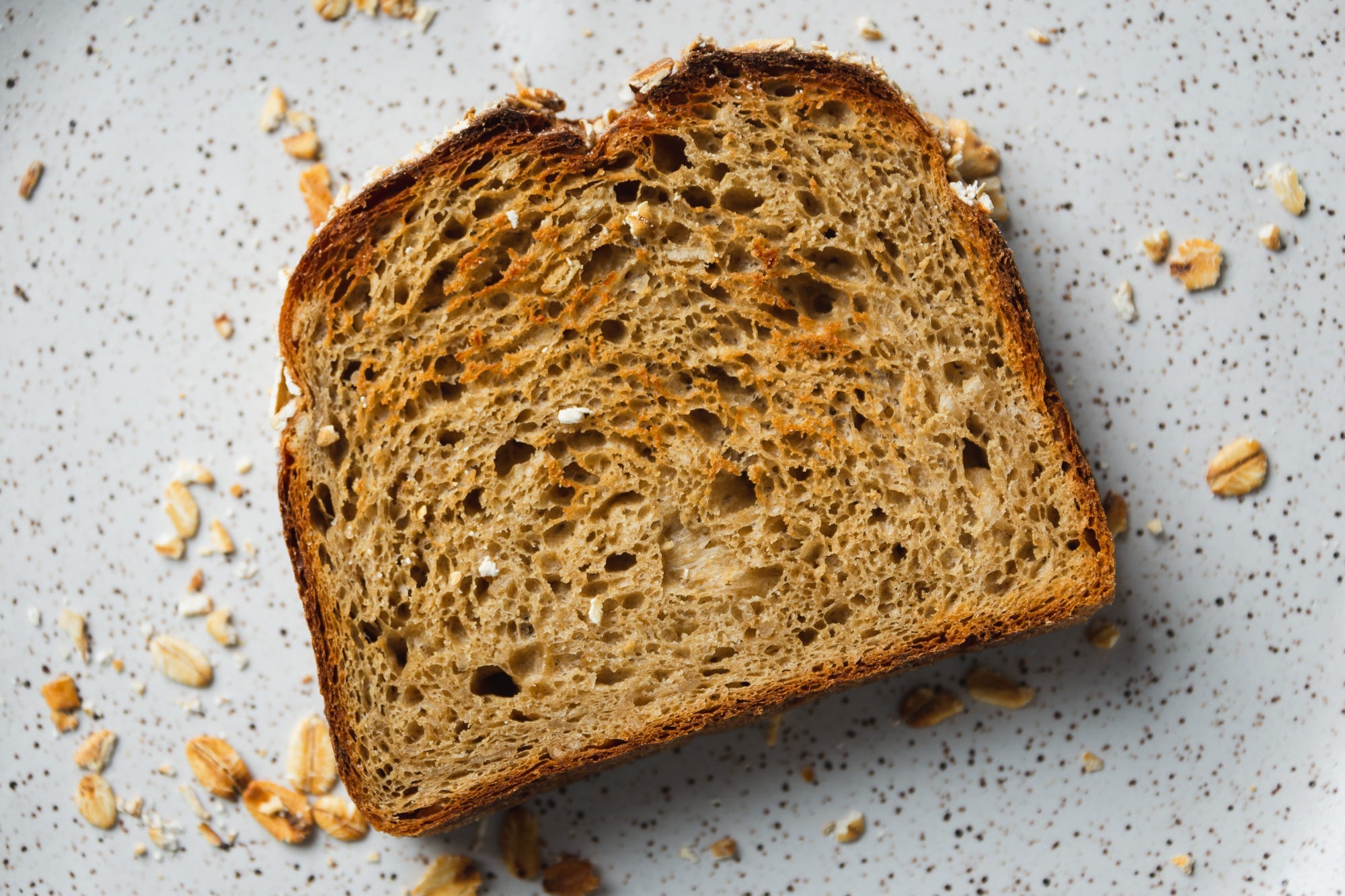Recipe: Renewal Mill Oat Milk Flour Sandwich Bread

Oat Milk Flour, Oatmeal, and Maple Sandwich Bread
Makes one 700g 9x5-inch pan loaf
- You can purchase Renewal Mill oat milk flour from some supermarkets, or from them directly (use the code RMFLOUR20 for a 20% discount).
- If you’d like to make this recipe before you source oat milk flour, you can eliminate it and increase the amount of rolled oats in step one to 75g and the amount of bread flour in step 3 to 265g.
- Because this loaf benefits from extra gluten structure, use a true bread flour rather than a high-protein all purpose flour if possible.
- If you don’t have a spice mill to chop the oat topping, you can do it by hand or simply leave them whole.
Overall Formula
80% bread flour
20% Renewal Mill oat milk flour
15% old-fashioned rolled oats
100% water
8% maple syrup
5% butter
1% instant yeast
2.2% salt
Porridge
45g old-fashioned rolled oats, plus 2 tablespoons, coarsely ground in a spice mill (to top loaf)
60g Renewal Mill oat milk flour
180g boiling water
25g maple syrup
14g (1 tablespoon) unsalted butter, cold
Dough
120g 75˚F water
235g bread flour
3.2g (3/4 teaspoon) instant yeast
7g (1 1/4 teaspoons) sea salt
FOR THE PORRIDGE: Place the oats and oat milk flour in a medium bowl and whisk to combine. Pour the boiling water over the oat mixture and whisk until uniform. Cover the bowl with a plate, and let sit for 20 minutes.
Add the maple syrup and butter to the oat mixture and stir with a spatula until incorporated. Allow to sit, uncovered, until cooled to room temperature, about 20 minutes.
FOR THE DOUGH: Place about 10 grams (~2 teaspoons) of the cool water in a small bowl and set aside. Add the remaining water to the oat mixture, and stir with wooden spoon or dough whisk until combined. Add the flour and yeast and stir with a wooden spoon or dough whisk until uniform and no dry flour remains. Add the salt and reserved water to the top of the dough. Cover the bowl and let sit for 30 minutes.
Using your hands, knead, mash, and squeeze the dough in the bowl until the water and salt are fully incorporated and the dough is uniform in texture. Cover well, and let proof at cool room temperature (68 to 75 degrees) for 45 minutes.
Gently deflate the dough and fold its edges into the center, then turn it over in the bowl, cover again, and let sit until the dough is about doubled in volume, 30 to 60 minutes longer.
Dust the top of the dough lightly with flour, loosen from the bottom of the bowl, and invert it onto a floured countertop. Using flour on your hands and on the top of the dough as necessary to prevent sticking, gently press the dough into an 8-inch circle, then fold the edges of the circle toward the middle to form a round. Invert the dough, cover with the bowl, and let rest for 30 minutes. Meanwhile, grease a 9- by 5- or 8½- by 4½-inch loaf pan and set it aside.

Flour the top of the dough and surrounding countertop. Using a bench scraper, loosen the dough from the counter and invert. Using flour on your hands and the top of the dough as necessary to prevent sticking, gently press the dough into an 8-inch circle. Fold the lower quarter of the dough toward the center to form a 3/4-moon shape. Gently stretch the left and right sides of the dough outward to elongate it, then fold each side toward the center to form a rectangle. Fold the top flap toward the center and then roll the loaf over itself toward you to form a compact cylinder. Gently roll the log back and forth under your cupped hands to elongate it. Place the loaf seam side down in the prepared pan, pressing the dough gently toward the corners (the dough may not fill the pan completely).
Cover the pan loosely with plastic wrap or enclose in a plastic bag and let rise until the top of the loaf is about 1 inch above the lip of the pan (for standard pans; for pullman-style pans—as in the gif above—proof until about 1/2 inch below the lip of the pan), 45 to 90 minutes. Meanwhile, adjust an oven rack to the middle position, set a covered heavy-bottomed Dutch oven on the rack, and heat the oven to 450 degrees. Fold an 18- by 13-inch piece of parchment in half lengthwise and set aside.
9. Using a mister bottle or brush, lightly moisten the top of the loaf with water. Using a lame, sharp serrated knife, or single-edge razor blade, make a single ¼-inch-deep slash lengthwise down the center of the loaf. Coat top of loaf with the remaining oats, avoiding the slashed area. Center the pan crosswise on the prepared parchment sling and transfer to the preheated Dutch oven. Cover the pot and transfer to the oven. Bake the bread for 20 minutes.
Remove the pot from oven and remove the lid. Using parchment sling as handles, carefully remove the loaf from the pot. Set the parchment and Dutch oven aside, return the loaf pan to the oven, and continue to bake until the loaf is deep brown and registers 210 degrees at its center, 15 to 20 minutes longer.
Transfer the pan to a wire rack and let cool for 5 minutes. Remove the loaf from the pan, return to the wire rack, and let cool completely before slicing and serving, about 2 hours.






Member discussion